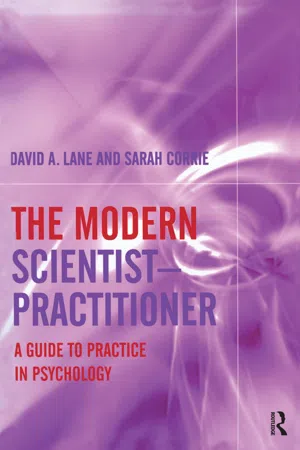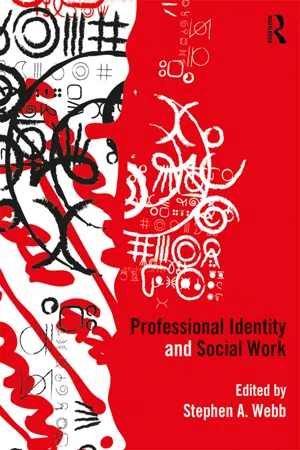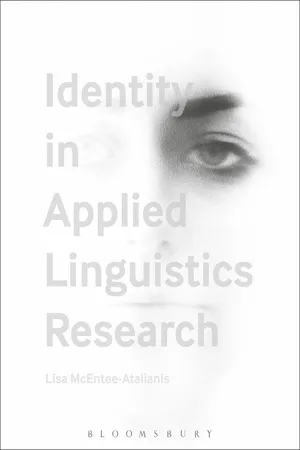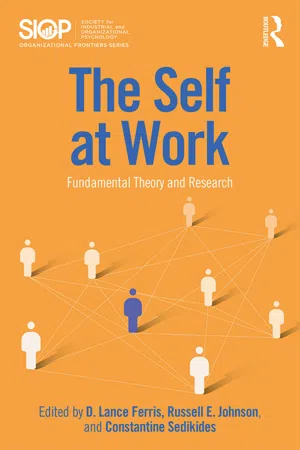Social Sciences
Workplace Identity
Workplace identity refers to the way individuals perceive themselves within the context of their work environment. It encompasses how employees define themselves in relation to their job roles, organizational culture, and professional relationships. Workplace identity can influence job satisfaction, motivation, and overall well-being, as it shapes individuals' sense of belonging and purpose within the workplace.
Written by Perlego with AI-assistance
Related key terms
9 Key excerpts on "Workplace Identity"
- eBook - ePub
Work and Life Integration
Organizational, Cultural, and Individual Perspectives
- Ellen Ernst Kossek, Susan J. Lambert(Authors)
- 2004(Publication Date)
- Psychology Press(Publisher)
Social identity encompasses a person's total psychological identification with social groups and roles that are deemed meaningful and important in shaping attitudes, beliefs, and behaviors (Deaux, 1993 ; Hooper, 1985 ; Tajfel, 1978). How we see ourselves and how we interact with others is shaped strongly by our social identity (Garza & Borchert, 1990). People perceive themselves as having different roles in their daily personal and work life and some roles or identities are more important than others in how they define themselves and how much they are willing to invest themselves in a particular role (Bielby & Bielby, 1989 ; Krause, 1995). Supervisors who perceive their work roles as responsive and supportive with subordinates may be more apt to engage in helpful interactions with workers than supervisors who perceive their roles with subordinates as only task-centered. Studies applying social identity theory to organizations and occupational groups have demonstrated high levels of work group identification, understanding, and salience of group membership (Alderfer & Smith, 1982 ; Allen & Stephenson, 1983 ; Ashforth & Mael, 1989 ; Kramer, 1991). In fact, at work, a person's self-concept derives from both the work group and the organi-zation as a whole. The cognitive connections or identification that individual members have with their organization influences the kinds of interactions and behaviors that they engage in with other members of the organization (Dutton et al, 1994). Organizational identification can be described as the extent to which a person's self-concept “has many of the same characteristics he or she believes define the organization as a social group” (p. 239). Interpersonal consequences of employees' strong organizational identification include increased cooperation and effort toward coworkers and enhanced work group cohesion characterized by trust and a psychological attachment to work group members (Dutton et al., 1994) - eBook - ePub
The Modern Scientist-Practitioner
A Guide to Practice in Psychology
- David A. Lane, Sarah Corrie(Authors)
- 2007(Publication Date)
- Routledge(Publisher)
In this chapter, we consider what it means to claim an identity as a scientist– practitioner, over and above adherence to any activity or method. In inviting you to consider what this might mean for your own practice, we consider both the work of the psychologist and the conceptual perspectives that inform it, within the broader context of social identity. We also explore how social representations within our peer group and of the broader profession might inform and direct our practice.SOCIAL IDENTITY AND THE PRACTICE OF PSYCHOLOGY
Work is typically a major source of social identification in people’s lives. In professional and occupational groups, this identification includes colleagues, professional bodies, and unifying beliefs. It involves long-term social contacts and forms a context in which occupational or professional category can be a major determinant of interpersonal interaction. Similarly, it has been suggested that the scientist–practitioner model represents an identity through which we organize and make sense of our professional beliefs, actions and communications with others (see Aspenson et al., 1993). Thus we have claimed the identity but in claiming it, we need to consider the implications of that identity in practice.Identity is itself an area of psychological study. In looking at what it means to be a scientist–practitioner we must, therefore, also look at social identity processes and the emergence of a concept of the professional.Studies investigating social identity and the link with the organizational processes underpinning professional activity have emerged over the last two decades (Ashforth and Mael, 1989; Fox et al., 1984; Lane et al., 2000; Oaker and Brown, 1986; Schiffmann and Wagner, 1985; Siporin, 1984; Zani, 1987). In addition to exploring social identity, work on the social representation of professional practice has been used to explore the development of shared beliefs and the ways in which these shared beliefs direct social action (see, for example, Amerio and Ghiglione, 1986; Hayes, 1991; Herzlich, 1973; Hewstone, 1983; Lalljee et al - Adam Barnard(Author)
- 2017(Publication Date)
- Routledge(Publisher)
Upon the commencement of engaging in a professional role, as individuals, each of us arrives with our own, unique personal identity. Our social identities, however, are arguably shaped not by personal identity but by the labels that others attach to us through collectively observing, processing and interpreting our behaviours. Arguably, this collision of personal and social identity in organizational settings has consequences which impact on how we see ourselves and how colleagues see us. After all, what we consider we ‘bring to the party’ and how our behaviour ‘at the party’ is interpreted, may involve multiple perspectives! Fortunately, the concepts of ‘self’ and ‘identity’ should be considered to be dynamic factors that we have the ability to influence and change throughout our professional careers as we engage in reflective practices and develop new approaches to situations, re-inventing how we see ourselves and attempting to outwardly demonstrate practice that influences how others perceive us. Niemi (1997) describes this process of self-reflection as reshaping identity due to questioning the personal view and, in turn, students of a profession may be viewed as active participants in forming their professional identities. The workplace, therefore, might be viewed as a melting pot which impacts upon the construction of both ‘self’ and ‘identity’ (Haslam 2001).As a student embarking upon a career in a professionally recognized arena or as an existing professional entering a new role, the process requires the learning and delivery of new skills to be applied in the workplace in accordance with the social boundaries and rules which regulate or steer behaviour in the particular work-based setting. Van Maanen and Schein (1979: 226) describe these social rules as ‘appropriate mannerisms, attitudes and social rituals’ to which a subject must outwardly give the impression of compliance or potentially risk a lack of effectiveness – or worse, the removal of the opportunity to fulfil the role (Ibarra 1999; Leary and Kowalski 1990; Goffman 1959). Thus, Van Maanen and Schein (1979) propose that those who appear to conform, comply or ‘act out’ such behaviours are accepted ‘into the fold’, having been granted inclusion through demonstrating their ability to formulate corresponding identities to those of their colleagues.Professional identities have a conflicting mix of self-identity, self-concepts, self-esteem and ideal self. Professional identity is defined as one’s professional self-concept based on attributes, beliefs, values, motives and experiences (Ibarra 1999; Schein 1978). Bleakley (2004) notes that professional identity is shaped by discourse between individuals, which is a continuous process, impacting on the social construction of professional identities. Social Identity Theory (SIT) (Tajfel and Turner 1986) and Self Categorization Theory (SCT) (Turner et al. 1987) do not entertain the notion that professional groups differ from other group identities – post-categorization processes, professionals will become members of the most favourable in-group(s), which may also enhance their personal identity if their attachments and relationships within the group grow stronger, leading to self-verification, self-gratification and a greater sense of self-esteem (Tajfel 1978).- eBook - ePub
- Stephen A. Webb(Author)
- 2017(Publication Date)
- Routledge(Publisher)
Chapter 16 in this volume). Indeed, in some important corners social work is worried about giving up too precipitously the “identity” of the profession. In the UK this is especially true in relation to concerns about the so-called loss of identity in the face of health and social care integration. It is felt that having a strong professional identity is likely to buffer the impact of threats to social workers’ collective identity. In light of this, the ongoing generativity around matters of professional identity and the sustained concentration should not be that surprising.The present book, the first of its kind in social work, examines professional identity – its nature, development and application – in social work through a social science lens. Indeed, throughout the book you will witness the way various authors draw on this rich interdisciplinary field to make sense of professional identity. The book demonstrates the significance of professional identity because of its links to a wide range of experiences, contexts, values and institutional locations that otherwise would not be associated in social work.It has been indicated that identity has been subject to a searching critique in the social sciences. This is partly because there are so many diverse perspectives that have invoked it. It is also because of both the indiscriminate usage of the concept and its populist appeal. Once we dip into issues of professional identity in social work we soon discover they have been vexed by conceptual ambiguity, lack of consensus about core attributes and problems in identifying what counts in the constitution of identity. Studies have tended to focus on social workers’ professional identity formation; the framing of key tensions around social workers’ professional identity; issues which convey narrative representations of social workers in talking about their role, values and work; and the educational context in which professional identity is formed in preparation for front-line practice (Webb, 2016). All this makes it a kind of laboratory, then, for thinking about matters of professional identity. - eBook - ePub
- Lisa McEntee-Atalianis(Author)
- 2018(Publication Date)
- Bloomsbury Academic(Publisher)
see Angouri & Marra 2011a for a book-length introduction). The aims of this chapter are therefore to review and represent a selection of this research, exploring identity construction and performance in diverse workplace settings (including institutional and professional 1 contexts) and genre. A vast array of theoretical and analytical approaches have been applied to this study, and as will become evident, scholarship in this relatively young field of investigation has applied the tenets and frameworks of varied approaches: ethnography, conversation analysis, corpus linguistics, critical discourse analysis, interactional sociolinguistics, pragmatics, metaphor analysis and narrative analysis, to name but a few. The sections below discriminate between scholarship that has prioritized different issues: the first two sections consider workplace roles; the third reviews what is now a large area of interest in workplace research, gender studies (Baxter 2010; Holmes 2006; Mullany 2007, 2010) and the final section addresses the increasingly pertinent question of the impact of globalization and ‘transnational ism’ on Workplace Identity/ies. Apprentice, worker and professional/institutional identity In this section, we consider the discursive enactment and (co-)construction of apprentice, worker and (temporary) professional/institutional identity. In the case of ‘temporary’ identity/ies, we review research that has explored the performative and sometimes temporary/multiple roles that individuals perform in workplace contexts, such as when acting as ‘mentor’ in corporate or academic contexts, or as ‘expert witness’ in a law court. We begin with studies that have mapped the terrain of the apprentice/newcomer as they enter into new communities of workplace practice - eBook - ePub
The Self at Work
Fundamental Theory and Research
- D. Lance Ferris, Russell E. Johnson, Constantine Sedikides(Authors)
- 2017(Publication Date)
- Routledge(Publisher)
Finally, identity processes obtained some initial attention within engagement research. Generally, identity refers to a “self-referential description that provides contextually appropriate answers to the question ‘Who am I?’ or ‘Who are we?’” (Ashforth, Harrison, & Corley, 2008, p. 327; see also the van Knippenberg and Hogg chapter in this volume). Within organizations, people can derive their identities from group memberships (social identity, Haslam & Ellemers, 2005), from their “unique sense of self” (personal identity; Postmes & Jetten, 2006) or from particular roles they fulfill within the organization (Stryker & Burke, 2000).Research that has linked social-identity processes to work engagement are based on the following premise: Social identification with the organization implies that the employee experiences a strong connection with the organization. This connection in turn fosters orientations and behaviors that are consistent with organizational goals (Ashforth & Mael, 1989). One way of behaving in accordance with the organization’s goal is to demonstrate high work engagement, that is, employing the self at work, and being dedicated and absorbed. Thus, when identification with the organization is high, employees should experience excitement and vigor while working. Findings based on cross-sectional research provide initial support to this idea (He, Zhu, & Zheng, 2014; Karanika-Murray, Duncan, Pontes, & Griffiths, 2015). Moreover, in workgroups in which leaders support social identity, work engagement is higher than in workgroups in which leaders do not show this behavior (Steffens, Haslam, Kerschreiter, Schuh, & van Dick, 2014). However, the power of social identity may not be equally strong for people with a low versus high organizational tenure. In an experimental study that simulated organizational-socialization processes, Cable, Gino, and Staats (2013) reported that not organizational identification, but personal identity enhanced engagement. Having a strong sense of one’s self seems to boost work engagement. - Jasmin Mahadevan, Claude-Hélène Mayer(Authors)
- 2017(Publication Date)
- Routledge(Publisher)
Previous research has emphasized that identity constructions in organizations may be reduced to cultural stereotyping, culturalization processes and generalizations about ascribed identity aspects (Mayer and Louw, 2011). The reduction of identities to one-dimensional constructs, which might be related to the national belonging of an individual, racial aspects, gender, age or professional belonging, can lead to conflictual situations at work and in organizational settings. Hence, the perception of identities should rather be extended to multi-dimensional and social identity constructs which take multiple notions of identity into account (Mayer, 2008).In organizations, the (re-) construction of identity and self refers to self-ascriptions of ‘who I am’ or ‘who we are’, as well as to socio-culturally constructed identities of ‘who they are’, which are situationally and contextually created within value frameworks (Mayer, 2008), as indicated by Taylor (1989). Individuals ‘strive to shape their personal identities in organizations and are being shaped by discursive forces’ that are dynamic and in constant processes of being constructed and deconstructed (Sveningsson and Alvesson, 2003, p. 1165). At the same time, constructed docile group membership within organizations leads to self-categorizations and social-categorizations, and the transformation of the self is seen as underpinning group phenomena, self-perception processes and the perception and behaviour of the relevant in-group prototype construction. These social identity processes within organizations relate to constructed organizational norms, stereotyping, ethnocentrism, positive in-group attitude and cohesion, cooperation, emotional contagion and collective behaviour, and mutual influence and power relations (Hogg and Terry, 2014).Organizational identity research usually focuses on the impact of organizational identity (Brown, 2001; 2015) on organizational success (Collins and Porras, 1996) and on enhancing proactivity (Gioia and Thomas, 1996). Identity is considered a major resource in managing and leading organizations (Glynn, 2000) and leadership is seen in the context of power, context and identity (Gagnon and Collinson, 2014). Organizational identity constructs, therefore, interlink individual, inter-personal, social and organizational levels of construction (Humphreys and Brown, 2002) and should, in the best case, lead to constructive organizational images of the self and others, and membership identification (Baringa and Kärreman, 2013; Keupp, 2004a; 2004b), as well as to strengthened relationships across individuals and groups within organizations (Sharp, 2014). Gioia and Patvardhan (2012) emphasize that identity in organizations and organizational identity are no longer to be seen as an entity, or ‘thing’, or ‘being’, but rather as a never-ending process or flow. Organizations may even be seen as having multiple identities (Harrison 2000; Pratt and Foreman, 2000). Ravasi and Schultz (2006), therefore, point out that organizational identity is based on collective perceptions and shared understandings regarding the important characteristics of organizational identity. Hence, organizations should relate to the shifting spaces within themselves, thereby addressing the need for the construction of multiple identities (Gaisch, 2014). Then, multiplicity can create positive commitment in organizations and motivation (Jacobs, 2013).- eBook - ePub
- Lena Dominelli(Author)
- 2017(Publication Date)
- Bloomsbury Academic(Publisher)
CHAPTER 4 IDENTITY: A PERSONAL MATTER OR A POLITICAL ISSUE? IntroductionIdentity tends to be seen as a personal matter despite feminist declarations that ‘the personal is political’. In this chapter, identity is considered a phenomenon that is created in and through interactions between individuals and groups, so that identity is formed in the process of creating others and being created by them. Thus, identity is configured as fluid and negotiated rather than fixed and essentialised. Expressions of identity are differentiated according to social divisions and the audience with which one interacts, and vary over time. In this context, diversity in identity formation becomes an important consideration of practice and social workers are encouraged to check with the individual, family, group or community that they are working with precisely how they interpret their own identity rather than presume that they know because they can apply a particular label to them. The role of religion in configuring identities will also be explored as it constitutes a particular dimension of specific identities, although its significance can differ according to country. Additionally, I consider the use of religion as a tool of oppression aimed at turning indigenous communities in Canada, Australia and the USA into ‘European’ ones. And I examine the impact upon social work practice of the rise of fundamentalist views of religions across the globe.Narratives of place and space situate individuals in given geographic locales and account for differences in their identity attributes (Massey and Denton, 1993). Inclusive narratives are utilised to ensure that no voices are silenced. They also create spaces of approval, acceptance and belonging, whereby people are made to feel part of the body politic, hold the right to have rights, engage in political processes and otherwise enact agency in their everyday lives. Adherents of biological racism racialise biological attributes like skin colour by casting one colour as superior and others inferior in comparison and encapsulating an entire identity within it. - eBook - ePub
New Ways of Organizing Work
Developments, Perspectives, and Experiences
- Clare Kelliher, Julia Richardson(Authors)
- 2011(Publication Date)
- Routledge(Publisher)
What alternative view of identity can be offered? One which may help us not only to see worker subjectivity in a more complex way, but which may also illuminate more fully the complexity of workers’ responses to new work practices. Identity is, of course, about who we are and who we are not, but it is never entirely fixed, nor solely individually defined. In the pro- and anti-identification camps, worker identity only seems to be important to the extent that workers identify with, or resist, organizational aims. Thus identity is framed only with respect to the degree of assimilation or resistance to organizational aims\managerial goals. However, the wealth of work on various aspects of worker identity calls this dichotomy into question. For example, one can identify (or disidentify, or be somewhere in between) with elements of task, role, coworkers, team, client, customer, etc. For example, studies of more highly skilled workers tend to show that such individuals identify more with their occupation or professional group rather than employing organization (Cooke, Hebson & Carroll, 2005). Recent work on organizational identity (e.g., Gallie, White, Cheng & Tomlinson, 1998; Sveningsson & Alvesson, 2003) has recognized that workers display multiple identities and that these shift over time and in specific contexts. Indeed, many would suggest that rather than focus upon the concept of ‘identity’, which has connotations of being one thing rather than another, we should think in terms of ‘identifications’. This shift in language moves us from an entitative (an identity) to a more processual view of identifications.BUILDING A SENSE OF ‘IDENTITY’: IDENTIFICATIONS AND DIS-IDENTIFICATIONS
In essence, my work joins those who approach identity “as a temporary, context-sensitive and evolving set of constructions rather than a fixed, abiding essence” (Alvesson, Lee Ashcraft and Thomas, 2008, 6; or see Alvesson & Willmott, 2002). Part of my aim in this chapter is to build on such work by exploring themes in Bakhtin’s writing (1986, 1993) that may help us to develop even richer accounts of identity work. Bakhtin’s writing has influenced work in the social constructionist (Gergen, 1989; Shotter, 1989, 1993) stream and cultural theory (Reckwitz, 2002). The key value of social constructionist work on identity is to recast situated identity work as a creative space from which multiple possibilities can emerge. There is, however, a particular sense of ‘being’ that is missing from social constructionist accounts of the emergence of self. Discursive events are not just sites of possibility, but also acts in which multiple centers of emotional/valuational/cognitive consciousnesses meet. It is the person’s situated identity work that is the focus of interest, and how she or he takes up, rejects and interweaves life history with situated discursive possibilities. Bakhtin’s (1993) writing on the ‘novelistic self’ is relevant here. His contribution is to present a dialogic, agentive account of our participation in discursive interaction. There is some resonance between Bakhtin’s position and the social constructionist focus on the human agent in the social process of creating and using meaning within social relationships. However, relating his writing to contemporary studies of identity would entail a theoretical focus on the acting/thinking/feeling person in relationship with others (rather than, for example, identifying ‘dominant discourses). The ‘person’ may be constituted by discourses, yet she is still capable of critical historical reflection and is able to exercise some choice with respect to the discourses and practices she takes up in ongoing interactions. The following section draws on empirical examples (both from my own research and that of others) of situated identity work to illustrate the potential of some Bakhtinian concepts to add to our understanding of identification processes. In these accounts the person is portrayed not as a passive consumer of dominant discourses or a militant hero eschewing all managerial machinations, but a feeling/thinking/acting person struggling with day-to-day experiences.
Learn about this page
Index pages curate the most relevant extracts from our library of academic textbooks. They’ve been created using an in-house natural language model (NLM), each adding context and meaning to key research topics.








